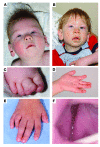Cholesterol precursors and facial clefting
- PMID: 16955133
- PMCID: PMC1555658
- DOI: 10.1172/JCI29872
Cholesterol precursors and facial clefting
Abstract
Inborn errors of cholesterol synthesis cause human malformation syndromes, including Smith-Lemli-Opitz syndrome, lathosterolosis, desmosterolosis, X-linked dominant chondrodysplasia punctata type 2, and congenital hemidysplasia with ichthyosiform erythroderma and limb defects. Because adequate cholesterol is not transported across the placenta, low cholesterol and elevated sterol precursor levels are present during embryogenesis. It has been debated whether the malformations result from low cholesterol or the buildup of sterol precursors. In this issue of the JCI, Engelking et al. provide evidence that sterol precursor accumulation plays a pivotal role in the genesis of facial malformations (see the related article beginning on page 2356).
Figures


Comment on
-
Severe facial clefting in Insig-deficient mouse embryos caused by sterol accumulation and reversed by lovastatin.J Clin Invest. 2006 Sep;116(9):2356-65. doi: 10.1172/JCI28988. J Clin Invest. 2006. PMID: 16955138 Free PMC article.
References
-
- Irons M., Elias E.R., Salen G., Tint G.S., Batta A.K. Defective cholesterol biosynthesis in Smith-Lemli-Opitz syndrome. Lancet. 1993;341:1414. - PubMed
-
- Shackleton C., Roitman E., Guo L.W., Wilson W.K., Porter F.D. Identification of 7(8) and 8(9) unsaturated adrenal steroid metabolites produced by patients with 7-dehydrosterol-delta7-reductase deficiency (Smith-Lemli-Opitz syndrome). J. Steroid Biochem. Mol. Biol. 2002;82:225–232. - PubMed
-
- Wassif C.A., Yu J., Cui J., Porter F.D., Javitt N.B. 27-Hydroxylation of 7- and 8-dehydrocholesterol in Smith-Lemli-Opitz syndrome: a novel metabolic pathway. Steroids. 2003;68:497–502. - PubMed

